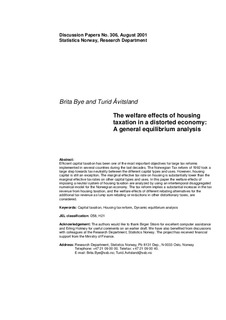| dc.contributor.author | Bye, Brita | |
| dc.contributor.author | Åvitsland, Turid | |
| dc.date.accessioned | 2011-11-25T20:02:48Z | |
| dc.date.available | 2011-11-25T20:02:48Z | |
| dc.date.issued | 2001 | |
| dc.identifier.issn | 1892-753x | |
| dc.identifier.uri | http://hdl.handle.net/11250/180495 | |
| dc.description.abstract | Abstract:
Efficient capital taxation has been one of the most important objectives for large tax reforms implemented in several countries during the last decades. The Norwegian Tax reform of 1992 took a large step towards tax neutrality between the different capital types and uses. However, housing capital is still an exception. The marginal effective tax rate on housing is substantially lower than the marginal effective tax rates on other capital types and uses. In this paper the welfare effects of imposing a neutral system of housing taxation are analyzed by using an intertemporal disaggregated numerical model for the Norwegian economy. The tax reform implies a substantial increase in the tax revenue from housing taxation, and the welfare effects of different rebating alternatives for the additional tax revenue as lump sum rebating or reductions in other distortionary taxes, are considered.
Keywords: Capital taxation, Housing tax reform, Dynamic equilibrium analysis | no_NO |
| dc.language.iso | eng | no_NO |
| dc.publisher | Statistics Norway, Research Department | no_NO |
| dc.relation.ispartofseries | Discussion Papers;No. 306 | |
| dc.subject | Capital taxation | no_NO |
| dc.subject | Taxation | no_NO |
| dc.subject | Housing taxation | no_NO |
| dc.subject | Welfare effects | no_NO |
| dc.subject | general equilibrium analysis | no_NO |
| dc.subject | JEL classification: D58 | no_NO |
| dc.subject | JEL classification: H21 | no_NO |
| dc.title | The welfare effects of housing taxation in a distorted economy: A general equilibrium analysis | no_NO |
| dc.type | Working paper | no_NO |
| dc.subject.nsi | VDP::Social science: 200::Economics: 210::Economics: 212 | no_NO |
| dc.source.pagenumber | 32 s. | no_NO |
